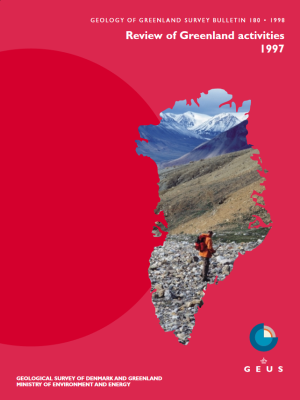Hydrothermal activity in the Upper Permian Ravnefjeld Formation of central East Greenland – a study of sulphide morphotypes
DOI:
https://doi.org/10.34194/ggub.v180.5090Abstract
Bituminous shales of the Ravnefjeld Formation were deposited in the subsiding East Greenland basin during the Upper Permian. The shales are exposed from Jameson Land in the south (71°N; Fig. 1) to Clavering Ø in the north (74°20′N) and have attracted considerable attention due to their high potential as hydrocarbon source rocks (Piasecki & Stemmerik 1991; Scholle et al. 1991; Christiansen et al. 1992, 1993a, b). Furthermore, enrichment of lead, zinc and copper has been known in the Ravnefjeld Formation on Wegener Halvø since 1968 (Lehnert-Thiel 1968; Fig. 1). This mineralisation was assumed to be of primary or early diagenetic origin due to similarities with the central European Kupferschiefer (Harpøth et al. 1986). Later studies, however, suggested base metal mineralisation in the immediately underlying carbonate reefs to be Tertiary in age (Stemmerik 1991). Due to geographical coincidence between the two types of mineralisation, a common history is a likely assumption, but a timing paradox exists. A part of the TUPOLAR project on the ‘Resources of the sedimentary basins of North and East Greenland’ has been dedicated to re-investigation of the mineralisation in the Ravnefjeld Formation in order to determine the genesis of the mineralisation and whether or not primary or early diagenetic base metal enrichment has taken place on Wegener Halvø, possibly in relation to an early period of hydrothermal activity. One approach to this is to study the various sulphides in the Ravnefjeld Formation; this is carried out in close co-operation with a current Ph.D. project at the University of Copenhagen, Denmark. Diagenetically formed pyrite is a common constituent of marine shales and the study of pyrite morphotypes has previously been successful from thermalli immature parts of elucidating depositional environment and thermal effects in the Alum Shale Formation of Scandinavia (Nielsen 1996; Nielsen et al. 1998). The present paper describes the preliminary results of a similar study on pyrite from thermally immature parts of the Ravnefjeld Formation which, combined with the study of textures of base metal sulphides in the Wegener Halvø area (Fig. 1), may provide an important step in the evaluation of the presence or absence of early thermal activity on (or below) the Upper Permian sea floor.
Downloads
Published
Issue
Section
License
This article is distributed under a CC-BY 4.0 licence, permitting free redistribution and reproduction for any purpose, even commercial, provided proper citation of the original work. Author(s) retain copyright over the article contents.


